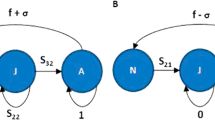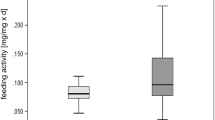Abstract
We assessed the short-term viability and recovery of zooplankton communities after exposure to glyphosate (active ingredient—a.i.). We conducted a hatching experiment in two steps: Step 1—natural lake sediments containing resting egg banks were placed into individual trays and exposed to a solution medium of glyphosate at three different treatments (LD = Values below the detection limits, LD < 0.05, 0.44, and 0.89 mg a.i./L) for 14 days; and Step 2—we replaced the exposure solution of glyphosate with distilled freshwater, keeping them all trays under freshwater conditions for another 14 day. The results from Step 1 showed significant effects of glyphosate on the emergence patterns of resting eggs, with a reduction in hatching of rotifers, mainly at concentrations of 0.44 and 0.89 mg a.i./L. On the other hand, the results from Step 2 showed an increase in the emergence of viable eggs for rotifers after restoration of freshwater conditions in all treatments; there was no effect for total zooplankton and microcrustaceans. These findings suggest that (i) glyphosate may, effectively, impair zooplankton hatching from resting egg banks; (ii) the magnitude of the negative effects depends on the the zooplanktonic group considered; and (iii) the restoration of freshwater conditions may, in some way, allow the recovery of the zooplankton community from viable egg banks. Our results can be useful in predicting the influence of glyphosate on the distribution patterns of freshwater zooplankton, which can represent vital information for environmental managers.



Similar content being viewed by others
References
Alekseev V, Makrushin A, Hwang JS (2010) Does the survivorship of activated resting stages in toxic environments provide cues for ballast water treatment? Mar Pollut Bull 61:254–258. https://doi.org/10.1016/j.marpolbul.2010.02.022
Angeler DG, García G (2005) Using emergence from soil propagule banks as indicators of ecological integrity in wetlands: advantages and limitations. J North Am Benthol Soc 24:740–752. https://doi.org/10.1899/05-025.1
Blaustein L (1997) Non-consumptive effects of larval Salamandra on crustacean prey: can eggs detect predators? Oecologia 110:212–217. https://doi.org/10.1007/s004420050152
Brock MA, Nielsen DL, Crosslé K (2005) Changes in biotic communities developing from freshwater wetland sediments under experimental salinity and water regimes. Freshwater Biol 50:1376–1390. https://doi.org/10.1111/j.1365-2427.2005.01408.x
Brock MA, Nielsen DL, Shiel RJ, Green JD, Langley JD (2003) Drought and aquatic community resilience: the role of eggs and seeds in sediments of temporary wetlands. Freshw Biol 48:1207–1218. https://doi.org/10.1046/j.1365-2427.2003.01083.x
Brock T, Bigler F, Frampton G, Hogstrand C, Luttik R, Martin LF, Topping CJ, Werf WV, Rortais A (2018) Ecological recovery and resilience in environmental risk assessments at the European food safety authority. Integr Environ Assess Manag 14:586–591. https://doi.org/10.1002/ieam.4079
Brock TCM, Van Solomon KR, Wijngaarden R, Maltby L (2008) Temporal extrapolation in ecological effect assessment of chemicals. In: Solomon KR, Brock TCM, De Zwart D, Dyer SD, Posthuma L, Richards SM, Sanderson H, Sibley PK, Van den Brink PJ (eds) Extrapolation practice for ecotoxicological effect characterization of chemicals. CRC Press, Boca Raton, FL, p 187–221
Broman E, Brüsin M, Dopson M, Hylander S (2015) Oxygenation of anoxic sediments triggers hatching of zooplankton eggs. P Roy Soc B-Biol Sci 282:2015–2025. https://doi.org/10.1098/rspb.2015.2025
Da Silva M, Peralba MCR, Mattos MLT (2003) Determinação de glifosato e ácido aminometilfosfônico em águas superficiais do arroio passo do pilão. Pesticidas: Revista de Ecotoxicologia e Meio Ambiente 13:19–18. https://doi.org/10.5380/pes.v13i0.3161
Domínguez-Cortinas G, Mejía-Saavedra J, Santos-Medrano GE, Rico-Martínez R (2008) Analysis of the toxicity of glyphosate and Faena® using the freshwater invertebrates Daphnia magna and Lecane quadridentata. Toxicol Environ Chem 90:377–384. https://doi.org/10.1080/02772240701529038
Edwards WM, Triplett Jr GB, Kramer RM (1980) A watershed study of glyphosate transport in runoff. J Environ Qual 9:661–665
EFSA Scientific Committee (2016) Scientific opinion on recovery in environmental risk assessments at EFSA. EFSA Journal 2:4313. https://doi.org/10.2903/j.efsa.2016.4313. 8
Elmoor-Loureiro LMA (1997) Manual de Identificação de Cladóceros Límnicos do Brasil. Universa, Taguatinga
Everett KDE, Dickerson HW (2003) Ichthyophthirius multifiliis and Tetrahymena thermophila tolerate glyphosate but not a commercial herbicidal formulation. Bull Environ Contam Toxicol 70:731–734
Gers A, Classen S, Strauss T, Ottermanns R, Brock TCM, Ratter HT, Hommen U, Preuss TG (2016) Ecological recovery potential of freshwater organisms: consequences for environmental risk assessment of chemicals. In: Reviews of environmental contaminations and toxicology 236:259–294. https://doi.org/10.1007/978-3-319-20013-2_5
Giesy JP, Dobson S, Solomon KR (2000) Ecotoxicological Risk Assessment for Roundup® Herbicide. In: Ware GW (ed) Reviews of Environmental Contamination and Toxicology. Springer, New York, NY, p 35–120. https://doi.org/10.1007/978-1-4612-1156-3_2
Gray DK, MacIsaac HJ (2010) Diapausing zooplankton eggs remain viable despite exposure to open-ocean ballast water exchange: evidence from in situ exposure experiments. Can J Fish Aquat Sci 67:417–426
Groner ML, Relyea RA (2011) A tale of two pesticides: how common insecticides affect aquatic communities. Freshw Biol 56:2391–2404. https://doi.org/10.1111/j.1365-2427.2011.02667.x
Gutierrez MF, Battauz Y, Caisso B (2017) Disruption of the hatching dynamics of zooplankton egg banks due to glyphosate application. Chemosphere 171:644–653. https://doi.org/10.1016/j.chemosphere.2016.12.110
Gyllström M, Hansson L (2004) Dormancy in freshwater zooplankton: induction, termination and the importance of benthic-pelagic coupling. Aquat Sci 66:274–295. https://doi.org/10.1007/s00027-004-0712-y
Hanazato T, Yasuno M (1990) Influence of time of application of an insecticide on recovery patterns of a zooplankton community in experimental ponds. Arch Environ Con Tox 19:77–83. https://doi.org/10.1007/BF01059815
IBAMA (2019) Relatório de Comercialização de Agrotóxico- Boletim anual de produção, importação, exportação e vendas de agrotóxico no Brasil. Ministério do Meio Ambiente, Brasília, http://www.ibama.gov.br/areas-tematicas-qa/relatorios-decomercializacao-de-agrotoxicos/pagina-3 Accessed 29 Dec 2020
Koste W (1978) Rotatoria die Rädertiere Mitteleuropas begründet von Max Voight. Monogononta. Gebrüder Borntraeger, Berlin
Lass S, Vos M, Wolinska J, Spaak P (2005) Hatching with the enemy: Daphnia diapausing eggs hatch in the presence of fish kairomones. Chemoecology 15:7–12. https://doi.org/10.1007/s00049-005-0286-8
MAPA (2010) Ministério da Agricultura, Pecuária e Abastecimento. Projeções do Agronegócio, Brasil, http://www.agricultura.gov.br/arq_editor/file/Ministerio/planos%20e%20programas/projecoes_web1.pdf a 2019/2020 Accessed 28 Oct 2020
Navis S, Waterkeyn A, Putman A, De Meester L, Vanermen G, Brendonck L (2015) Timing matters: sensitivity of Daphnia magna dormant eggs to fenoxycarb exposure depends on embryonic developmental stage. Aquat Toxicol 159:176–183. https://doi.org/10.1016/j.aquatox.2014.12.016
Navis S, Waterkeyn A, Voet T, De Meester L, Brendonck L (2013) Pesticide exposure impacts not only hatching of dormant eggs, but also hatchling survival and performance in the water flea Daphnia magna. Ecotoxicology 5:803–814. https://doi.org/10.1007/s10646-013-1080-y
National environmental council (2005) Resolução no. 357 de 17 de março de 2005. Diário Oficial da União, 53, pp. 58–66
Nielsen DL, Brock MA, Crosslé K, Harris K, Healey M, Jarosinski I (2003) The effects of salinity on aquatic plant germination and zooplankton hatching from two wetland sediments. Freshw Biol 48:2214–2223. https://doi.org/10.1046/j.1365-2427.2003.01146.x
Nielsen DL, Smith D, Petrie R (2012) Resting egg banks can facilitate recovery of zooplankton communities after extended exposure to saline conditions. Freshw Biol 57:1306–314. https://doi.org/10.1111/j.1365-2427.2012.02782.x
Ning NS, Petrie R, Gawne B, Nielsen DL, Rees GN (2015) Hypoxic blackwater events suppress the emergence of zooplankton from wetland sediments. Aquat Sci 77:221–230. https://doi.org/10.1007/s00027-014-0382-3
Pires NL, Passos CJS, Morgado MGA, Mello DC, Infante CMC, Caldas ED (2020) Determination of glyphosate, AMPA and glufosinate by high performance liquid chromatography with fluorescence detection in waters of the Santarém Plateau, Brazilian Amazon. J Environ Sci Heal 55:794–802. https://doi.org/10.1080/03601234.2020.1784668
Portinho JL, Nielsen DL, Daré L, Henry R, Oliveira RC, Branco CC (2018) Mixture of commercial herbicides based on 2,4-D and glyphosate mixture can suppress the emergence of zooplankton from sediments. Chemosphere 203:151–159. https://doi.org/10.1016/j.chemosphere.2018.03.156
Reid JW (1985) Chave de identificação para as espécies continentais sul americanas de vida livre da ordem Cyclopoida (Crustacea, Copepoda). Boletim de Zoologia, Universidade de São Paulo 9:17–143
Santangelo JM, Esteves FDA, Manca M, Bozelli RL (2014) Disturbances due to increased salinity and the resilience of zooplankton communities: the potential role of the resting egg bank. Hydrobiologia 722:103–113. https://doi.org/10.1007/s10750-013-1683-6
Sinhorin VDG, Sinhorin AP, Teixeira JMS, Miléski KML, Hansen PC, Moreira PSA, Kawashita NH, Baviera AM, Loro VL (2014) Effects of the acute exposition to glyphosate-based herbicide on oxidative stress parameters and antioxidant responses in a hybrid Amazon fish surubim (Pseudoplatystoma sp). Ecotox Environ Safe 106:181–187. https://doi.org/10.1016/j.ecoenv.2014.04.040
Stampfli NC, Knillmann S, Noskov YA, Schafer RB, Liess M, Beketov MA (2014) Environmental stressors can enhance the development of community tolerance to a toxicant. Ecotoxicology 2:1690–1700. https://doi.org/10.1007/s10646-014-1308-5
Tsui MTK, Chu LM (2003) Aquatic toxicity of glyphosate-based formulations: Comparison between different organisms and the effects of environmental factors. Chemosphere 52:1189–1197. https://doi.org/10.1016/S0045-6535(03)00306-0
US-EPA (1997) Environmental Protection Agency Method 300.1: Determination of Inorganic Anions in Drinking Water by Ion Chromatography, Revision 1.0 U.S. Environmental Protection Agency, Washington, DC
Van den Brink PJ, Van Wijngaarden RPA, Lucassen WGH, Brock TCM, Leeuwangh P (1996) Effects of the insecticide dursban® 4E (active ingredient chlorpyrifos) in outdoor experimental ditches: II. Invertebrate community responses and recovery. Environ Toxicol Chem 15:1143–1153. https://doi.org/10.1002/etc.5620150719
Acknowledgements
We are grateful to National Program for Post Doctoral of the Coordination for the Improvement of Higher Education Personnel (PNPD/CAPES) for the scholarship to JLP (process number 88882.317747/2013-01). The authors also would like to thank the São Paulo Research Foundation (FAPESP) (proc. 2014/22952-6) and National Council for Scientific and Technological Development (CNPq) (proc. 432172/2016-5) for financial support and a research grant to CCZB (proc. 306567/2014-8). We are grateful to the anonymous referees for giving valuable comments on the manuscript.
Funding
JLP was funded by National Program for Post Doctoral of the Coordination for the Improvement of Higher Education Personnel (PNPD/CAPES)—process number 88882. 317747/2013-01, addressed to postdoctoral fellowship in the Biosciences Graduate Program at São Paulo State University (UNESP).
Author information
Authors and Affiliations
Contributions
All authors contributed to the study conception and design. Material preparation, data collection and analysis were performed by JLP and HNO. The first draft of the manuscript was written by JLP and all authors commented on previous versions of the manuscript. All authors read and approved the final manuscript.
Corresponding author
Ethics declarations
Conflict of interest
The authors declare no competing interests.
Ethical approval
All applicable international, national, and/or institutional guidelines for the care and use of animals were followed.
Additional information
Publisher’s note Springer Nature remains neutral with regard to jurisdictional claims in published maps and institutional affiliations.
Supplementary information
Rights and permissions
About this article
Cite this article
Portinho, J.L., Oliveira, H.N. & Branco, C.C.Z. Resting egg banks can facilitate recovery of zooplankton communities after short exposure to glyphosate. Ecotoxicology 30, 492–501 (2021). https://doi.org/10.1007/s10646-021-02371-z
Accepted:
Published:
Issue Date:
DOI: https://doi.org/10.1007/s10646-021-02371-z




